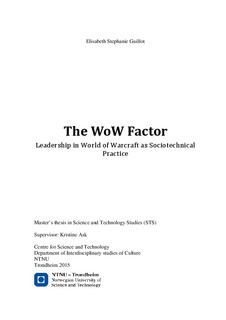| dc.description.abstract | This thesis looks at guild and raid leadership in World of Warcraft (WoW) in a social, technological, and material context. The goal is to look at how leadership is practiced and co-produced by a wide variety of actors (human and non-human) in a social network. Leadership is looked at through how it is designed in the game, and how it is understood by the users. My data material consists of four qualitative interviews and several blog posts. In analysing them, I have made use of the STS (Science and Technology Studies) theories of domestication, scripts, and user-scripts.
My findings include how technology and community together construct leadership in WoW. I have found that where players and leaders find weaknesses in the game’s design, they construct intricate systems to help them. This is illustrated by the widespread use of standardized systems for distributing high-value rewards (known to players as loot).
In looking at how leadership is structured, I saw how guilds organized and structured themselves. I found that while guilds followed the game’s script of meritocracy, they also sometimes disobeyed the game’s design where the social needs were prominent.
Raiding requires many resources, and in order for guilds to continue offering raiding to their members, leaders have taken on responsibilities to facilitate the activity. This includes offering a big and social atmosphere, and material goods and economic benefits.
The use of technologies is prominent among my informants. The player community has constructed set practices of playing WoW correctly. By becoming part of the playing community, players are enrolled into these practices, and expected to follow them. Gaining access to a guild requires taking part in these practices, which often are communicated through word-of-mouth. As such, playing WoW is also reliant on acquiring social and cultural capital.
In conclusion, I address the possibility that looking at leadership practices is a way to understand how leadership is learned through the idea that knowledge is learned through social and cultural dimensions in a community. Leaders are mentors more than they are bosses. The leadership is porous, meaning that the boundary between leader and follower is vague as they both move between the roles of leader and follower. | nb_NO |
